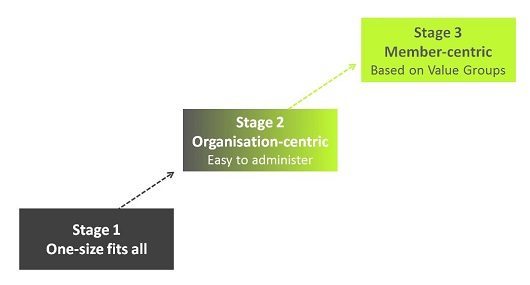Author: Sector Trainer and Consultant, Sue Froggatt
Many of today’s members look closely at value and I am often asked by membership associations for my thoughts on what is the best way to package value. The simplest ‘one-size and price fits all’ has the obvious problem that no-one enjoys paying for what they don’t need or want, so more choice is needed.
The first step
In the past, when a decision was made to offer a number of membership packages, the approach was often selected because it was easy to administer i.e. organisation-centric. For example, a trade association might base the price on the number of staff or turnover of the member, with larger companies paying more. The logic is the bigger they are, the more likely they are to use it. But what if this is not the case and is there a better option?
Value based approach
Professional institutes tended to use an approach based on what stage the member is at in their career. To illustrate, there is a different subscription rate and package for students, practicing professionals and seniors, like fellows. The assumption is that career stage is likely to reflect different wants and needs.
This sits more in alignment with what I favour – an approach based on what members need and want. By understanding what different groups of members are trying to achieve, you can determine what support they will find attractive.
Examples
Two traditional membership organisations that have value based membership models are Salem Area Chamber of Commerce and British Cycling.
Salem has designed five offerings to fit their members’ business goals:
- Getting connected (Business – the entry level)
- Promoting their business (Entrepreneur)
- Making a difference via political action (Premium)
- Representing business interest (Executive)
- Strengthening the economy (President’s Diamond Circle).
These may reflect the size of the organisation, but on the other hand, size may have little to do with their current business objectives.
British Cycling offers different packages to suit three groups of bike users with different priorities:
- Racing cyclists – tiered into bronze, silver and gold – allowing you to personalise further with various levels of insurance cover
- Regular riders
- Fans of cycling.
Developing the idea of a ‘fan’ further, I have noticed some organisations using models that reflect the type of relationship that the member wants. For example, The Guardian newspaper offers three options: Supporter (entry level), Partner and Patron. This approach is also likely to signal different wants, needs and experiences that have different value and price points.
These examples illustrate how the membership offer can be re-organised to provide better value and relevance to suit the needs different groups of members. The move to member-centric packages provides a more sound, resilient and robust footing from which to grow membership.
(The typical stages of membership model development)
The process
The process of developing new packages usually starts with research that clusters members into different groups. This is known as ‘segmenting’ your membership. The segmentation experts say the most powerful way to segment is by what people need and want*1 . This is confirmation that this is a good way to move forward, with ‘Value Group’ thinking providing an ideal and firm platform for growth.
The key advantages of segmenting are that you will:
- Focus everyone on what the members want and need
- Give staff a better understanding of the services and products that the members would welcome
- Have a powerful tool for crafting more compelling value propositions
- Build resilience by offering more flexibility, allowing members to upgrade or downgrade pathway if their situation changes (rather than drop out of membership)
- Have an option to offer special extras as add-on’s, so members can personalise their package.
Final thoughts
A few parting tips when changing your model:
- Make sure it is simple and easy for members to understand the differences between the options
- Don’t overwhelm members with too many options – that will cause hesitation, delay and have a psychological cost (too much mental effort!!)
- Design packages that fit into and touch members everyday lives, as this will build an on-going relationship.
While some membership organisations might be at risk in the future because of poor value propositions in the new digital and networked age, it is not the membership model that is the issue. The membership model is very much alive and booming, especially given the commercial sectors interest in a ‘re-occurring revenue’ and ‘forever transaction’ that only stops when the customer cancels.
I will talk more about the drivers of change and new sources of value for membership organisations during my presentation at Membership Excellence 2016 on 21st April in London. Hope to see you there!









Leave A Comment